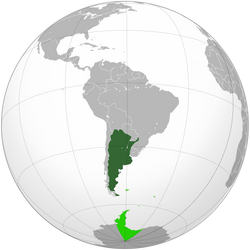|
República Argentina | |
| Federation | |

|

|
| Motto En unión y libertad In Unity and Freedom | |
| Anthem Himno Nacional Argentino | |
| Capital | Buenos Aires |
| Government | Presidential republic |
| President | |
| - From 2007 | Cristina Fernández de Kirchner |
| Legislature | Congress |
| - Upper house | Senate |
| - Lower house | Chamber of Deputies |
| History | |
| - May 25, 1810 | May Revolution |
| - July 9, 1816 | Declared |
| - May 1, 1853 | Current constitution |
| Area | 2,766,890 km² |
| Population | |
| - 2010 | 40,091,359 |
| Density | 14.4/km² |
| GDP | 2010 (PPP) |
| - Total | US$ 625.5 billion |
| - Per capita | US$ 15,603 |
| Currency | Peso |
| v | |
The Argentine Republic is a presidential republic in South America.
Background
In 1816, the United Provinces of the Rio Plata declared their independence from Spain. After Bolivia, Paraguay, and Uruguay went their separate ways, the area that remained became Argentina. The country's population and culture were heavily shaped by immigrants from throughout Europe, but most particularly Italy and Spain, which provided the largest percentage of newcomers from 1860 to 1930. Up until about the mid-20th century, much of Argentina's history was dominated by periods of internal political conflict between Federalists and Unitarians and between civilian and military factions. After World War II, an era of Peronist populism and direct and indirect military interference in subsequent governments was followed by a military junta that took power in 1976. Democracy returned in 1983 after a failed bid to seize the Falkland (Malvinas) Islands by force, and has persisted despite numerous challenges, the most formidable of which was a severe economic crisis in 2001-02 that led to violent public protests and the successive resignations of several presidents.[1]
Economy
Argentina benefits from rich natural resources, a highly literate population, an export-oriented agricultural sector, and a diversified industrial base. Although one of the world's wealthiest countries 100 years ago, Argentina suffered during most of the 20th century from recurring economic crises, persistent fiscal and current account deficits, high inflation, mounting external debt, and capital flight. A severe depression, growing public and external indebtedness, and a bank run culminated in 2001 in the most serious economic, social, and political crisis in the country's turbulent history. Interim President Adolfo RODRIGUEZ SAA declared a default - the largest in history - on the government's foreign debt in December of that year, and abruptly resigned only a few days after taking office. His successor, Eduardo DUHALDE, announced an end to the peso's decade-long 1-to-1 peg to the US dollar in early 2002. The economy bottomed out that year, with real GDP 18% smaller than in 1998 and almost 60% of Argentines under the poverty line. Real GDP rebounded to grow by an average 8.5% annually over the subsequent six years, taking advantage of previously idled industrial capacity and labor, an audacious debt restructuring and reduced debt burden, excellent international financial conditions, and expansionary monetary and fiscal policies. Inflation also increased, however, during the administration of President Nestor KIRCHNER, which responded with price restraints on businesses, as well as export taxes and restraints, and beginning in early 2007, with understating inflation data. Cristina FERNANDEZ DE KIRCHNER succeeded her husband as President in late 2007, and the rapid economic growth of previous years began to slow sharply the following year as government policies held back exports and the world economy fell into recession. The economy has rebounded from the 2009 recession, but the government's continued reliance on expansionary fiscal and monetary policies risks exacerbating already high inflation, which remains under-reported by official statistics.[2]
President
- Cristina Fernández de Kirchner (₩) (December 10, 2007 - )
Nation
Argentine Polities
Argentine Antarctica (From 1942)
Neighbouring Nations
References
- Argentina: Guide to Law Online (Library of Congress)
- Argentina: Location Map 2013 (UN OCHA, PNG)
- The World Factbook (CIA)
- Chiefs of State and Cabinet Members of Foreign Governments (CIA)
- U.S. Department of State
- Australian Government
- Inter-Parliamentary Union - Senate
- Inter-Parliamentary Union - Chamber of Deputies
- BBC News Country Profile
- BBC News Time Line
- World Statesmen.org
- International Constitutional Law Project
- Psephos Election Archive
- Wikisource 1911 encyclopedia project
- Wikipedia
